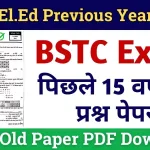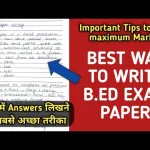The Don Bosco question bank is a comprehensive educational resource designed to assist students in learning and preparing for exams. It includes a variety of questions and answers across all subjects, helping students grasp core concepts and excel academically. This guide provides subject-wise questions and answers for enhanced understanding.
English
Question: What is the definition of a noun?
Answer: A noun is a word used to identify a person, place, thing, or idea.
Question: What are the types of sentences?
Answer: The four types of sentences are declarative, interrogative, imperative, and exclamatory.
Question: Define a verb with an example.
Answer: A verb is a word that denotes an action, occurrence, or state. Example: Run, jump, is.
Question: What is the difference between “their” and “there”?
Answer: “Their” indicates possession, while “there” refers to a place.
Question: What is a simile?
Answer: A simile is a figure of speech comparing two things using “like” or “as.”
Question: Define an adjective.
Answer: An adjective is a word that describes or modifies a noun.
Question: What is the function of a conjunction?
Answer: A conjunction connects words, phrases, or clauses in a sentence.
Question: How is a compound sentence formed?
Answer: A compound sentence is formed by joining two independent clauses using a conjunction.
Question: What are homophones?
Answer: Homophones are words that sound the same but have different meanings and spellings.
Question: Define an adverb with an example.
Answer: An adverb modifies a verb, adjective, or another adverb. Example: Quickly.
Question: What is the subject of a sentence?
Answer: The subject is the person or thing performing the action or being described.
Question: What are auxiliary verbs?
Answer: Auxiliary verbs, or helping verbs, assist the main verb in forming tenses, moods, or voices.
Question: Define a preposition with an example.
Answer: A preposition shows the relationship between a noun or pronoun and other words. Example: In, on, at.
Question: What is an interjection?
Answer: An interjection is a word or phrase that expresses strong emotion. Example: Wow!
Question: What is the past tense of “go”?
Answer: The past tense of “go” is “went.”
Question: Differentiate between “its” and “it’s.”
Answer: “Its” shows possession, while “it’s” is a contraction of “it is.”
Question: What is a synonym?
Answer: A synonym is a word that has the same or a similar meaning as another word.
Question: Define an antonym.
Answer: An antonym is a word that has the opposite meaning of another word.
Question: What is direct speech?
Answer: Direct speech quotes someone’s exact words, enclosed in quotation marks.
Question: Define indirect speech.
Answer: Indirect speech conveys what someone said without quoting their exact words.
Mathematics
Question: What is the value of Pi?
Answer: Pi is approximately equal to 3.14159.
Question: Define a prime number.
Answer: A prime number has exactly two factors: 1 and itself.
Question: What is the formula for the area of a rectangle?
Answer: Area = Length × Breadth.
Question: Explain the Pythagoras theorem.
Answer: In a right triangle, the square of the hypotenuse equals the sum of the squares of the other two sides.
Question: What is the perimeter of a circle?
Answer: The perimeter of a circle, also known as the circumference, is 2πr.
Question: Define a fraction.
Answer: A fraction represents a part of a whole, expressed as a numerator over a denominator.
Question: What is the difference between mean and median?
Answer: The mean is the average of a data set, while the median is the middle value when data is ordered.
Question: What are parallel lines?
Answer: Parallel lines are two lines that never meet and are equidistant at all points.
Question: Define a right angle.
Answer: A right angle measures exactly 90 degrees.
Question: What is an acute angle?
Answer: An acute angle measures less than 90 degrees.
Question: What is a decimal?
Answer: A decimal is a fraction expressed in a base-10 system, using a decimal point.
Question: Define a rational number.
Answer: A rational number is a number that can be expressed as a fraction where both the numerator and denominator are integers.
Question: What is an irrational number?
Answer: An irrational number cannot be expressed as a simple fraction and has non-repeating, non-terminating decimals.
Question: What is a polygon?
Answer: A polygon is a closed figure with three or more straight sides.
Question: Explain the concept of slope in geometry.
Answer: Slope measures the steepness or incline of a line, calculated as the ratio of vertical change to horizontal change.
Question: What is the value of 2³?
Answer: The value of 2³ is 8.
Question: Define probability.
Answer: Probability is the measure of the likelihood of an event occurring, expressed as a fraction or percentage.
Question: What is a histogram?
Answer: A histogram is a graphical representation of data using bars to show frequency distributions.
Question: What is the formula for the volume of a cylinder?
Answer: Volume = πr²h, where r is the radius and h is the height.
Science
Question: What is photosynthesis?
Answer: Photosynthesis is the process by which plants use sunlight to synthesize food from carbon dioxide and water.
Question: Define gravity.
Answer: Gravity is the force of attraction between two objects with mass.
Question: What is the boiling point of water?
Answer: The boiling point of water is 100°C or 212°F at standard atmospheric pressure.
Question: What is the unit of force?
Answer: The unit of force is the Newton (N).
Question: What are the three states of matter?
Answer: The three states of matter are solid, liquid, and gas.
Question: What is an atom?
Answer: An atom is the basic unit of matter, consisting of protons, neutrons, and electrons.
Question: Define an ecosystem.
Answer: An ecosystem is a community of living organisms interacting with their physical environment.
Question: What is the speed of light?
Answer: The speed of light is approximately 299,792 kilometers per second.
Question: Explain the law of conservation of energy.
Answer: Energy cannot be created or destroyed; it can only be transformed from one form to another.
Question: What is a chemical reaction?
Answer: A chemical reaction involves the transformation of substances into new substances with different properties.
Question: What is the function of the heart?
Answer: The heart pumps blood throughout the body, supplying oxygen and nutrients.
Question: What is the pH scale?
Answer: The pH scale measures the acidity or alkalinity of a solution, ranging from 0 to 14.
Question: What is a renewable resource?
Answer: A renewable resource is a natural resource that can be replenished over time, such as sunlight or wind.
Question: Define a chemical element.
Answer: A chemical element is a pure substance made up of only one type of atom.
Question: What is the role of chlorophyll in plants?
Answer: Chlorophyll absorbs sunlight, enabling the process of photosynthesis.
Question: What is the human skeletal system?
Answer: The human skeletal system is a framework of bones that supports the body and protects internal organs.
Question: What is evaporation?
Answer: Evaporation is the process by which a liquid turns into a gas.
Question: Define kinetic energy.
Answer: Kinetic energy is the energy possessed by a moving object.
Question: What is a galaxy?
Answer: A galaxy is a large system of stars, gas, dust, and dark matter bound together by gravity.
Question: What is an enzyme?
Answer: An enzyme is a protein that accelerates chemical reactions in the body.
History
Question: Who was the first President of India?
Answer: Dr. Rajendra Prasad was the first President of India.
Question: What is the significance of the year 1947 in India?
Answer: India gained independence from British rule in 1947.
Question: Who discovered America?
Answer: Christopher Columbus is credited with discovering America in 1492.
Question: What was the Industrial Revolution?
Answer: The Industrial Revolution was a period of major industrialization that began in the 18th century.
Question: What is the Great Wall of China?
Answer: The Great Wall of China is a series of fortifications built to protect against invasions.
Question: Who was Mahatma Gandhi?
Answer: Mahatma Gandhi was a leader of India’s independence movement and an advocate of non-violence.
Question: What was the French Revolution?
Answer: The French Revolution was a period of social and political upheaval in France from 1789 to 1799.
Question: What is the importance of the Harappan civilization?
Answer: The Harappan civilization was an advanced ancient culture known for urban planning and trade.
Question: Who was Abraham Lincoln?
Answer: Abraham Lincoln was the 16th President of the United States and led the country during the Civil War.
Question: What was the Cold War?
Answer: The Cold War was a period of political tension and military rivalry between the USA and USSR after World War II.
Question: Who was Ashoka the Great?
Answer: Ashoka was a Mauryan emperor known for spreading Buddhism and his policy of non-violence.
Question: What is the Magna Carta?
Answer: The Magna Carta was a charter signed in 1215 limiting the powers of the English monarchy.
Question: What is the United Nations?
Answer: The United Nations is an international organization founded in 1945 to promote peace and cooperation.
Question: What is the Renaissance?
Answer: The Renaissance was a cultural movement marking the revival of art, literature, and learning in Europe from the 14th to 17th centuries.
Question: Who was Napoleon Bonaparte?
Answer: Napoleon Bonaparte was a French military leader who became Emperor of France.
Question: What is the significance of the Battle of Plassey?
Answer: The Battle of Plassey in 1757 marked the beginning of British rule in India.
Question: Who wrote the Indian Constitution?
Answer: Dr. B.R. Ambedkar was the principal architect of the Indian Constitution.
Question: What is the Berlin Wall?
Answer: The Berlin Wall divided East and West Berlin from 1961 to 1989 and symbolized the Cold War.
Question: What is the Silk Road?
Answer: The Silk Road was an ancient trade route connecting Asia and Europe.
The Don Bosco question bank serves as a vital educational tool, fostering knowledge and preparing students for academic challenges. By mastering these questions and answers, students can build a strong foundation across various subjects and excel in their studies.
Latest Posts
- Step-by-step guide to download and apply for jee mains admit card 202
- Comprehensive 2025 government holidays and recruitment details for job seekers
- JEE Mains Admit Card 2025: Your Step-by-Step Guide to Downloading the Hall Ticket
- Everything You Need to Know About 2025 Government Holidays Recruitment
- Comprehensive Guide to rrb d group recruitment 2025 – Eligibility, Vacancies, and Application
- Detailed guide to nps trust recruitment 2025 vacancies, eligibility and apply process
- Comprehensive guide to hpcl recruitment 2025 notification, vacancies, and application process
- ignou bed admission 2025 complete recruitment guide with eligibility and process
- Comprehensive Guide to Indian Army Agniveer Recruitment 2025 Notification and Jobs
- Everything You Must Know About CBSE Board Exams 2025 Changes & New Rules






